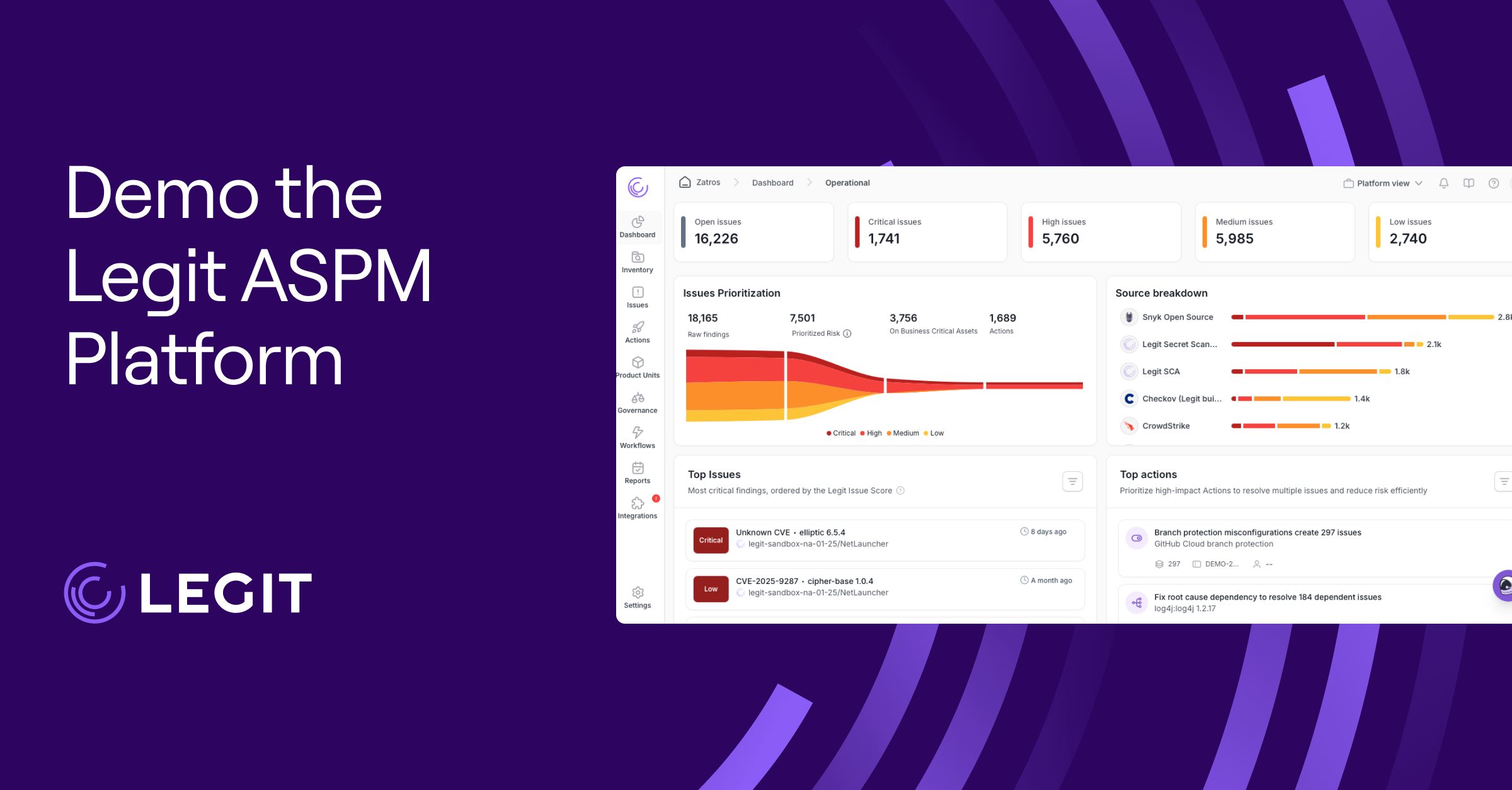Application Security Orchestration and Correlation (ASOC) used to be positioned as a leading edge solution to safeguard an organization's applications, providing a strategic framework that integrates various AppSec tools and processes to more comprehensively mitigate vulnerabilities and protect against evolving threats.
However, new challenges in application security, particularly with software supply chain vulnerabilities, DevOps, and cloud-based apps have revealed the limitations of ASOC in today's threat landscape. As a result, a more adaptive and comprehensive solution — Application Security Posture Management (ASPM) has emerged to address the limitations found within ASOC frameworks and replace them.
In this article, we’ll explore ASOC, its benefits, shortcomings, gaps, and why organizations should transition to ASPM to better secure their software supply chains and software delivery.
What is ASOC?
Application Security Orchestration and Correlation (ASOC) is a solution category that addresses the critical task of safeguarding applications from potential security and risk threats. At its core, ASOC integrates various application security tools and solutions, combining findings, data sources, and analyses for a much more efficient manner of aggregating all the data that can come from these multiple tools. These individual tools are designed to identify, assess, and mitigate security vulnerabilities in code, open source libraries, and other aspects application software, but are often very noisy and produce disparate vulnerabilities within context or prioritization that slow development and security teams down.
ASOC attempts to provide a holistic approach to application security, bridging the gap between development and deployment, empowering organizations to proactively protect their applications by streamlining security processes, automating threat detection, and ensuring rapid incident response in a much more comprehensive manner.
History of ASOC Security
Before the emergence of ASOC, the cybersecurity landscape relied on prior approaches: Application Vulnerability Coordination (AVC) and Application Security Testing Orchestration (ASTO). These methodologies were effective to some extent, but they began to struggle after 2010 given the sheer volume and complexity of security data and signals.
Recognizing the need for a more unified and comprehensive approach, Gartner formally merged AVC and ASTO in 2019 into ASOC. This merger aimed to provide organizations with a more adaptable and responsive strategy for securing their applications while addressing the need to more efficiently handle the data and signals application security tools provided.
In 2023, Gartner formally acknowledged that Application Security Posture Management (ASPM) will supersede ASOC. ASPM represents the next evolution in application security, focusing on the continuous assessment and improvement of application security from code development into production, further enhancing organizations' ability to protect their applications.
To best manage and mitigate the multiple risks that come with an increasingly complex development environment, Gartner recommends that organizations adopt ASPM and transition their environment accordingly. Below we will summarize the historical benefits of ASOC, and readers should know that these benefits and many new ones are now provided by ASPM.
Benefits of ASOC Security
Application Security Orchestration and Correlation (ASOC) offers a range of benefits that significantly simplifies the security process for developers and security teams. This includes:
1. Time Efficiency
ASOC is designed to save time for AppSec and DevSecOps teams. Without ASOC, these teams are often burdened by time-consuming tools, vulnerability noise, and vendor management. Prior to ASOC, data analysis and correlation was often a manual process, and having to sift through potentially dozens of tools with thousands of data points can lead to errors and prevent dev teams from doing more important work. ASOC tools help automate many of these processes, allowing developers to focus on the more important priorities. This automation also accelerates the development lifecycle while ensuring that security measures are consistently applied.
2. Well-Defined Security KPIs
ASOC helps organizations establish KPIs to measure their progress towards addressing security risks and vulnerabilities. This ensures that the ASOC is materially contributing to your security and can help your team prioritize key risks and vulnerabilities.
3. Continuous & Automated Security Scanning
ASOC tools provide continuous and automated security scanning, constantly monitoring applications for vulnerabilities and threats, even in dynamic environments. This includes visibility of all assets and environments, saves time, and reduces the chance of overlooked vulnerabilities. It also ensures that any new threats within your environment is found immediately, allowing for a rapid response.
4. Streamlined Vulnerability Management
ASOC simplifies the vulnerability management process through correlation and orchestration. By aggregating and correlating data from various security tools, organizations can identify the most critical vulnerabilities and their potential impact in a streamline way. It solves a key challenge for security teams — being bogged down by multiple security tools, too much noise, and an overabundance of alerts, and potential threats.
5. Enhanced Threat Intelligence
A streamlined vulnerability management process and better security data analysis translates to a more robust threat intelligence capability. This intelligence helps security teams stay ahead of emerging threats, anticipate potential attack vectors, and implement proactive security measures before they expose their organization.
ASOC tools play a pivotal role in enhancing cybersecurity, especially if it has evolved to meet modern cybersecurity needs. However, despite all the benefits of ASOC, there are clear limitations and organizations are likely better served by a more comprehensive framework like ASPM.
Challenges & Limitations of ASOC
While ASOCs present a powerful framework for enhancing application security, it is essential to understand its limitations and why it was replaced by ASPM.
1. Addressing Root Problems
ASOC doesn't inherently address the root causes of security vulnerabilities, it merely reports and generates awareness of potential issues. ASOC tools automate security processes to provide insights, but it’s not enough to actually eliminate any vulnerability in your code or environment at its source.
2. Data Correlation Complexity
ASOC often involves using multiple tools to accumulate data from various sources. While this diversity of data can provide comprehensive insights, correlating this data between tools can be a complex and time-consuming endeavor. Ensuring that the data from different tools aligns seamlessly within ASOC requires continuous configuration and ongoing maintenance, which can strain development resources.
3. Lack of Application Context
ASOC operates without a deep understanding of the application's context. This means that configuration and rule-setting are left primarily to development engineers, who must continuously adapt to the evolving nature of their environment and applications. As applications change and expand, maintaining accurate configurations within ASOC to understand what application threats to look for becomes its own operational challenge.
4. Limited Production Visibility
ASOC tools do not offer production visibility or traceability, which is necessary for thorough application security testing. ASOC and integrated tools can scan source code in repositories but that doesn’t always reflect the exact state of what is currently deployed. In complex environments with numerous repository branches, it can be challenging to ensure that security assessments align with the actual production environment, affecting overall visibility.
5. Weak Risk Scoring
ASOC struggles with providing useful risk scoring. The use of a wide variety of tools can result in an overwhelming number of security alerts, making it difficult to properly score which threats require immediate attention. This lack of granularity and context can lead to a situation where multiple security threats, from ASOC and integrated tools, are scored as critical. Over time, this can hinder a department’s ability to address vulnerabilities that should be high-priority, potentially exposing the organization to risk.
6. Integration Complexity
Implementing ASOC within an organization's existing cybersecurity infrastructure can be complex and may require significant integration technical expertise. Ongoing maintenance can also be a significant issue, especially if developer resources are already strained.
Balancing the advantages of automation and orchestration with the need for prioritized threat mitigation is crucial for effective application security. ASOC tools can be extremely useful, but ASPM is proving to be a better choice for most organizations.
ASOC vs. ASPM: Will ASPM Replace ASOC?
Application Security Posture Management (ASPM) is quickly becoming the preferred successor to ASOC, largely because it addresses many of the limitations we summarized above. Here are some of the ways ASPM better serves an organization’s need for comprehensive application security.
1. Contextual Threat Assessment
ASPM doesn’t only report on discovered bugs and vulnerabilities, it leverages contextual information from code to cloud to analyze the root cause of vulnerabilities. By understanding the broader context in which these vulnerabilities exist, ASPM can more comprehensively assess the relative prioritization and remediation effort, leading to better efficiency and effectiveness.
2. Broad SDLC Integration
ASPM operates seamlessly in multiple stages of the Software Development Life Cycle (SDLC). This more comprehensive approach ensures that security measures are fully integrated and baked-in as part of the development process and software supply chain, reducing the likelihood of vulnerabilities escaping detection and making it easier to address issues early on.
3. Enhanced Risk Scoring and Management
ASPM is designed to streamline and centralize data sources, which allow it to offer clearer and more in-depth risk scoring and management capabilities compared to ASOC. It’s both precise and comprehensive, giving organizations the ability to prioritize vulnerabilities based on their criticality and potential impact so you can allocate resources more effectively and efficiently.
4. Remediation Guidance Within Workflow Tools
Operational and productivity issues are a major concern in modern application security management, especially as organizations grow. ASPM looks to solve that by being proactive when it comes to remediation, offering deep context and specific remediation guidance within workflow tools. This helps DevSecOps teams save time and align their security efforts with development more seamlessly.
5. Powerful Correlation
ASPM simplifies the correlation of security discoveries between multiple tools with grouped correlation alongside one-to-one findings. This streamlines how different security tools relate to each other, allowing security teams to cut through security issue noise and quickly assess the impact of vulnerabilities and potential threats.
Boost Your Software Supply Chain Security with ASPM
While ASOC was developed to address many of the concerns emerging from the use of cloud-based applications, it hasn’t proved to be enough to address the increased complexity of developer environments, the security needs of software development, and the operational challenges many DevSecOps teams encounter.
This has led to the rise of ASPM, which goes beyond vulnerability discovery and instead assesses threats contextually, is designed to integrate into the end-to-end software development lifecycle from code to cloud, and offers more applicable remediation guidance. In short, ASPM represents a major upgrade in application security and its adoption will only continue to increase.
Legit Security is a leader ASPM with a platform that can help organizations improve their vulnerability management, asset discovery, and secure their developer environments across the entire SDLC. To learn more about Legit Security, request a demo.
Download our new whitepaper.


